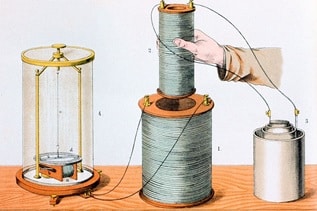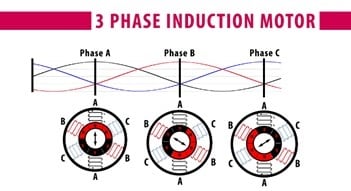3 Phase induction motor converts electrical energy into mechanical energy. The induction motor is the most popular choice. In industries, about 80 % of motors used are induction motors. These motors are most reliable, robust, and maintenance-free. In this post, we will learn the definition and working principle of an induction motor.
Nikola Tesla was one of the best innovators all over the world, in 1887 and 1888 Tesla had an experimental shop at 89 Liberty Street, New York, and there he invented the induction motor.
The use of the three-phase induction motors is increasing day by day after the invention of variable frequency drive. The induction motor is self-starting, reliable and economical. Moreover, we can also control the speed using the Variable Frequency Drive (VFD).
In this post, we will learn the principle of operation of an induction motor. Also, we will discuss its important role in the Automation Industry.
So, you might think that Tesla was just a scientist, but today you will find that Tesla was the greatest ever.
What is the meaning of the word “Induction”?
The production of an electromotive force across an electrical conductor in a changing magnetic field is induction. You might find this definition rather complicated. let me simplify it, according to Faraday;

- If we have a conductor and the electricity is passing through it. As a result, it will generate a magnetic flux (variable magnetic flux if the electricity is AC and fixed if it is DC).
- If we get that conductor “with its magnetic flux”, and moved it over an electric wire. As a result, that will generate a current in the wire, and that is a simply induction theory.
Summary
What we have said if a MOVING magnetic flux cuts an electrical conductor. Naturally, that will generate an electric current.
So, we could summarize the conditions for occurring the Electric Induction:
- Conductor
- Relative speed
- Magnetic flux
If you need an electric induction to happen you must ensure fulfillment of all these three conditions.
Electric conductors Vs. Magnets
You may confuse with the word “Magnetic Flux”, simply the magnetic flux generated by an electrical wire and the permanent magnet is the same.
Magnetic flux is what makes the magnet attract and apply forces on the metallic materials.

When we have a coil (conductor) and the electricity is passing through it, then, the coil acts as a magnet and it has the ability to attract and apply forces on metallic materials exactly like the magnet.
Structure of three-phase Induction Motors
The Induction motors consist of two main parts:
- Stator
As its name indicates stator is a stationary part of the induction motor. A stator winding (that is responsible for the generation of the rotating magnetic field) is the stationary winding placed in the stator slots of an induction motor. The stator winding receives the three-phase AC supply.
- Rotor
The rotor is the block of shorted conductors. The rotor is a rotating part of the induction motor. We connect the rotor to the mechanical load through the shaft.
Principle of operation of Induction Motor
Tell me what happened if we get two magnets and we put them side by side?
Of course, if the N pole of the first magnet is in front of the S pole of the other magnet, they would attract each other and Vic versa.
Let me ask you another question “what happened if we put a magnet (A) on a free rotation disk and we take another magnet (B) in our hands then we make circles around the magnet (A) with the magnet (B)”

Yap, I can hear you, the magnet (A) would rotate by the effect of the magnet (B), that is what exactly happens inside an induction motor.
- The Stator winding receives 3 phase Ac supply (which is 120o electrically & mechanically apart). And, this causes the stator to generate a ROTATING MAGNETIC FLUX with a speed of (120 f/P), where f represents the frequency and P is the number of poles.
- The rotating magnetic flux cuts the shorted ROTOR. This induces a voltage in the rotor.
- The voltage induced in the rotor causes rotor current flow in the rotor conductors.
- The rotating magnetic field of the rotor interacts with the main flux. The interaction of two fluxes produces the rotating torque in the rotor.
Advantages and disadvantages of Induction Motors
Advantages
- The induction motor is cheaper.
- It does not require any complex circuit for starting because the three-phase induction motor is self-starting.
- It can operate in a wide range of industrial conditions.
- The induction motors are simple and rugged construction. Therefore, it requires very minimal maintenance.
Disadvantages
- The main disadvantages of induction motor are that speed control of induction motor is difficult.
- Efficiency drops at low loads. At low loads, the power factor of the motor is poor that causing the motor to draw more current from the supply. As a result, the copper loss increase, and efficiency drops.
- Induction motors have inherently low starting torque. Therefore, induction motors are not useful for the applications like traction and high inertial loads.
Read Next :